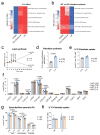SREBP1-induced fatty acid synthesis depletes macrophages antioxidant defences to promote their alternative activation
- PMID: 34531575
- PMCID: PMC7611716
- DOI: 10.1038/s42255-021-00440-5
SREBP1-induced fatty acid synthesis depletes macrophages antioxidant defences to promote their alternative activation
Abstract
Macrophages exhibit a spectrum of activation states ranging from classical to alternative activation1. Alternatively, activated macrophages are involved in diverse pathophysiological processes such as confining tissue parasites2, improving insulin sensitivity3 or promoting an immune-tolerant microenvironment that facilitates tumour growth and metastasis4. Recently, the metabolic regulation of macrophage function has come into focus as both the classical and alternative activation programmes require specific regulated metabolic reprogramming5. While most of the studies regarding immunometabolism have focussed on the catabolic pathways activated to provide energy, little is known about the anabolic pathways mediating macrophage alternative activation. In this study, we show that the anabolic transcription factor sterol regulatory element binding protein 1 (SREBP1) is activated in response to the canonical T helper 2 cell cytokine interleukin-4 to trigger the de novo lipogenesis (DNL) programme, as a necessary step for macrophage alternative activation. Mechanistically, DNL consumes NADPH, partitioning it away from cellular antioxidant defences and raising reactive oxygen species levels. Reactive oxygen species serves as a second messenger, signalling sufficient DNL, and promoting macrophage alternative activation. The pathophysiological relevance of this mechanism is validated by showing that SREBP1/DNL is essential for macrophage alternative activation in vivo in a helminth infection model.
© 2021. The Author(s), under exclusive licence to Springer Nature Limited.
Conflict of interest statement
K.P. is currently employed by AstraZenaca. J.S-R. has received funding from GSK and Sanofi and consultant fees from Travere Therapeutics. All the other authors declare no competing interests.
Figures














References
Publication types
MeSH terms
Substances
Grants and funding
- U105178805/MRC_/Medical Research Council/United Kingdom
- MC_UU_12012/2/MRC_/Medical Research Council/United Kingdom
- MC_UU_00014/2/MRC_/Medical Research Council/United Kingdom
- MC_U105178805/MRC_/Medical Research Council/United Kingdom
- 100963/Z/13/Z/Wellcome Trust (Wellcome)
- 100574/WT_/Wellcome Trust/United Kingdom
- MRC_MC_UU_12012/5/MRC_/Medical Research Council/United Kingdom
- 106260/Z/14/Z/Wellcome Trust (Wellcome)
- 100963/WT_/Wellcome Trust/United Kingdom
- 106260/WT_/Wellcome Trust/United Kingdom
- MC_G0802535/MRC_/Medical Research Council/United Kingdom
- 100574/Z/12/Z/Wellcome Trust (Wellcome)
- G0802051/MRC_/Medical Research Council/United Kingdom
- MC_UU_12012/5/MRC_/Medical Research Council/United Kingdom
- G0400192/MRC_/Medical Research Council/United Kingdom
- RG/12/13/29853/BHF_/British Heart Foundation/United Kingdom
- RG/18/7/33636/BHF_/British Heart Foundation/United Kingdom
LinkOut - more resources
Full Text Sources
Medical
Molecular Biology Databases
Research Materials

